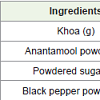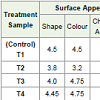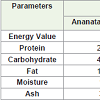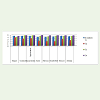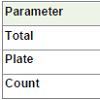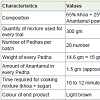Research Article
Development and Quality Evaluation of “Ananta (Hemedismus indicus) Enriched Pedha”
Mane P, Darshane P* and Joshi A
Department of Ayurved, Tilak Maharashtra Vidyapeeth, Pune-411037, India
Corresponding author: Priya Darshane, Department of Ayurved, Tilak Maharashtra Vidyapeeth, Pune-411037, India, E-mail: priya.darshane@ymail.com
Citation: Mane P, Darshane P, Joshi A. Development and Quality Evaluation of “Ananta (Hemedismus indicus) Enriched Pedha”. Indian J Nutri. 02 2017;4(2): 156.
Copyright © 2017 Mane P, et al. This is an open access article distributed under the Creative Commons Attribution License, which permits unrestricted use, distribution, and reproduction in any medium, provided the original work is properly cited.
Indian Journal of Nutrition | ISSN: 2395-2326 | Volume: 4, Issue: 2
Submission: 13/02/2017; Accepted: 29/03/2017; Published: 07/04/2017
Abstract
The study was undertaken to develop an innovative and nutrient dense dietary supplement for the purpose of gaining weight for underweight population. A novel, traditional Indian sweet, “Pedha” was fortified with Hemedismus indicus or Anatamul or Sariva root powder for its benefits such as balavardhak (aids in weight gain), blood purifier and a general tonic to boost energy levels. The fortification of Pedha with Sariva was assessed at various levels (T1 (control) to T4) using sensory and physico-chemical analysis. Based on sensory evaluation, the most acceptable treatment (T4: 65% Khoa + 25% powdered sugar + 10% Sariva root powder + 0.5% black pepper powder) was carried forward for quality analysis. A novel fortified Pedha was successfully developed and exhibited increased protein and carbohydrate values when compared with control sample. Sensory analysis with 10 semi trained panelists also exhibited highly desirable results in terms of product acceptability. Sariva root powder and black pepper powder fortification was carried out as per the reference found in ancient Ayurvedic literature, “Kshemakutuhala grantha”.
Keywords:
Anatamul; Hemedismus indicus; Pedha; Black pepper
Introduction
Pedha is a concentrated milk product having a satisfyingnutritional profile. It is calorie dense and has high biological value for proteins and may prove beneficial for undernourished segment of thepopulation. In addition to this, Pedha is a widely accepted, palatabletraditional Indian sweet meat, easy to prepare and consume even for children as well as for those with mastication issues. Being rich in nutrient value, it gains the sublime of the research.
Anantamul (Hemidesmus indicus, family: Asclepiadaceae) is receiving renewed attention as an Ayurvedic medicinal and herbal product that may have health benefits for blood purification, kidney and urinary disorders, and skin infections. It is also known as Sariva or Anantamul [1]. Roots of H. indicus are reported to contain chemical constituents like an essential oil containing 80% of 2-hydroxy 4-methoxy benzaldehyde, a ketone, fatty acids, saponin, tannins, resinal fractions, resin acids, sterols, sitosterol, stigmasterol and sarsapic acid. Hemidesmin1, hemidesmin2, alphaamyrin beta-amyrin, lupeol and 2-hydroxy-4-methoxy benzoic acid have been isolated and identified from roots of H. indicus [2]. Anantamul is described as having significant rejuvenative actions, rasayanakarmasma, such as asrukjit (cures disorders of blood), shukrala (increases semen), and garbhasthapana (stabilizes fetus)[3]. Anantamul’s protective effects have also been noted and have been linked to its chemical constituents, namely saponins, tannins,phenols, terpenoids, flavonoids, and coumarins [4]. An effective chemo-preventive agent in skin carcinogenesis in mice, Anantamul was capable of ameliorating hydroperoxide-induced cutaneous oxidative stress and tumor promotion [1].
Black pepper (Piper nigrum L.) has an impressive antioxidant and antibacterial effect and helps with digestion. Its active principle, piperine has been experimentally demonstrated by a number of independent investigators to possess diverse physiological effects [5].
According to Kshemakutuhalam grantha, black pepper has the property to reduce Kapha which may be generated in the body after consumption of heavy to digest and sweet products. The shloka mentioned in the grantha also suggests the same. Thus the product in the study also contains black pepper powder in suitable amount [6].
Due to above mentioned and other widely mentioned benefits of Hemedismus indicus, the present investigation was aimed to improve nutritional, health and sensory properties of Pedha, which might be useful for restoring nutritional status in cases of undernourishment.
Materials and Methods
Raw materials (Khoa, powdered sugar, black pepper powder) were procured from local supermarket of Pune area. Anatamul root powder was purchased from authorized Ayurvedic shop in Pune.
Ananta pedha development
Ananta Pedha was developed according to the method given by Kshemakutuhal grantha. It was assessed at various levels (T1-T4) and the most acceptable treatment was carried forward to further analysis.
Experimental trials
Four trials (T1-T4) of Pedha were carried out, first being the control one containing only khoa. In each trial, the amount of ingredients (Anantamul root powder, khoa, powdered sugar, blackpepper powder) was standardized and the best treatment [T4: khoa (65%), powdered sugar (25%), Anantamul root powder (10%) and black pepper powder (0.5%)] was selected using sensory evaluation by employing 10 semi-trained panelists, which was further used for quality analysis (Table 1).
Ananta pedha preparation: Pedhas were prepared according to the method by FAO (Technology of Traditional Milk Products in Developing Countries with some modifications in the formula. Instead of any other flavorings (saffron, cardamom etc.), Anantamul root powder was used as it not only possesses excellent aroma but also valued for medicinal properties. In addition, a different ingredient, black pepper powder was used in the basic formula for eliminating the risk of Kapha production is thought to be due to madhura (sweet) rasa as per Ayurvedic wisdom. Khoa, Anantamul powder, powdered sugar and black pepper powder blends were prepared in the ratio of T1 (200:0:75:0), T2 (200:20:30:2.5), T3 (200:25:50:2.5) and T4 (200:25:75:1.25) respectively.
While preparing Pedha, fresh khoa and powdered sugar were mixed and warmed on a low flame while stirring continuously. Once the mixture thickened and started forming firm balls, the mixture was removed from the fire. When the mixture cooled down to room temperature, Anantamul powder and black pepper powder were added as per the amounts mentioned. The mixture was mixed thoroughly and small round balls of about 15 gm each were rolled between the greased palms. Pedhas were stored in refrigerator for further evaluation.
Sensory analysis: Ananta pedhas were scored for surface appearance, interior appearance and eating characteristics (taste, texture, flavor, mouth-feel etc.) by a panel of 10 semi-trained judges on five points hedonic scale using score-card (Table 2).
Physico chemical analysis: Moisture, ash content, fat and protein content of the pedha were determined as per AOAC methods (1975). Protein was determined by Kjeldahl method using the conversion factor of 6.25 (N x 6.25). Carbohydrate content was determined by difference method (Table 3) (Figure 1).
Microbial analysis: Microbial analysis (TPC) of the Pedha wasperformed on Plate Count Agar (Table 4).
Results and Discussion
The ingredients used in the present investigation were nutritionally rich along with functional properties.
Development of pedha
For every batch of Pedha 300 gm of blend (65% khoa, 25% powdered sugar, 10% Anantamul powder, 0.5% black pepper powder). Every batch resulted in approximately 20 Pedhas. Every Pedha weighed around 15 gm with approximately 1.5 gm of Anantmul powder (Table 5) (Figure 2).
Physicochemical analysis
The tabulated data (Table 3) gives the details of proximate composition of test sample of the most acceptable trial (T4) and that of control sample (T1). It is observed that there was no significant difference in energy values of both the samples but proteins (20.14 gm) and carbohydrates (43.12 gm) of the test sample were on the higher side as compared to control sample.
Sensory analysis
The Table 2 gives the details of sensory evaluation of the Pedha samples. From the data it was observed that treatment 4 scored highest point in terms of organoleptic characteristics. The brown color and the test of the test sample were better acceptable than control sample (Table 2).
Microbial analysis
Microbial testing was carried out to study the microbial quality of the product. It was carried out on the day of production of Pedha (zero day) using nutrient agar on pour plate method.
Conclusion
An innovative, nutritious & palatable Pedha enriched withmedicinal properties of Anantamul (Hemedismus indicus) was successfully developed. These Pedhas can be especially recommended as a general tonic.
There is scope in the future to study the shelf life of the sample and further clinical implementation.
Acknowledgement
The author thanks Asst. Prof. Priya Darshane and Head of Dept.Prof. Dr. Abhijit H. Joshi for their meticulous guidance. The authoris also thankful to Tilak Maharashtra Vidyapeeth for providing thenecessary facilities in conducting the experiment.
References
- Weissner W (2014) Anantamul (Hemidesmus indicus): A review of biomedical studies and U.S products. Ayurveda J Health 12: 40-52.
- Singler P, Saksena R, Deepak D, Khare A (2000) C21 steroidal glycosides from Hemidesmus indicus. Phytochemistry 54: 983-987.
- Lakshmi TL, Rajendran R (2013) Hemidesmus indicus commonly known as indian sarasaparilla- an update. Int J Pharma Bio Sci 4: 397-404.
- Austin A (2008) A review on Indian sarasparilla, Hemedismus indicus (L.) R. Br. J of Biol Sci 8: 1-12.
- Vijaykumar RS, Surya D, Senthilkumar R, Nalini N (2002) Hypolipidemic effect of black pepper (Piper nigrum Linn.) in rats fed high fat diet. J Clin Biochem Nutr 32: 31-42.
- Tripathi I (1920) Kshemakutuhalam. 182.

